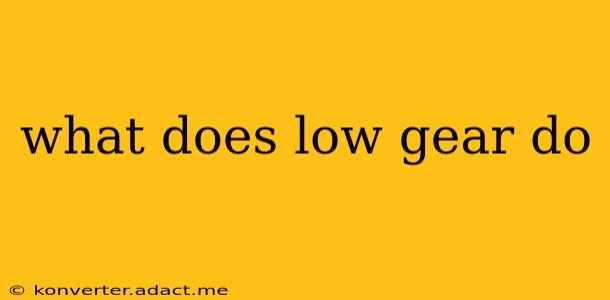What Does Low Gear Do? Understanding the Power of Low Gears
Low gear, whether in a car, bicycle, or other vehicle with gears, plays a crucial role in maximizing power and control, especially when tackling challenging situations. This article explores the function of low gear and answers common questions surrounding its use.
What is the purpose of low gear?
The primary purpose of low gear is to increase torque while decreasing speed. Torque is the rotational force that an engine produces, and it's what allows you to overcome resistance, like climbing a steep hill or towing a heavy load. In low gear, the engine's rotational force is amplified, making it easier to move forward despite the resistance. Think of it like using a lever – a longer lever gives you more leverage to move a heavy object. Low gear acts as that "longer lever" for your engine.
How does low gear work?
Gears work on the principle of mechanical advantage. In a low gear, the engine's revolutions are reduced, but the power is amplified. This means the engine spins slower, but each rotation exerts more force. The transmission changes the ratio of engine speed to wheel speed, providing greater torque at the wheels. It's a trade-off – you sacrifice speed for increased pulling power.
When should I use low gear?
Low gear is best utilized in situations where you need significant power to overcome resistance:
- Steep hills or inclines: This is perhaps the most common reason for using low gear. It provides the extra pulling power needed to ascend steep gradients without straining the engine.
- Heavy loads: Towing a trailer, caravan, or carrying a heavy payload requires the increased torque provided by low gear to maintain momentum.
- Starting off on a steep incline: Prevents stalling by providing sufficient power to overcome initial resistance.
- Off-road driving: Low gear is essential in off-road situations, providing the necessary traction and power to navigate challenging terrains.
What happens if I use low gear on a flat surface?
While you can use low gear on a flat surface, it's generally inefficient. The engine will rev higher than necessary, leading to increased fuel consumption and potential engine wear. You'll also be travelling at a much slower speed than if you were in a higher gear. Use low gear only when needed to overcome significant resistance.
Does low gear damage my vehicle?
Using low gear appropriately will not damage your vehicle. However, prolonged use of low gear on a flat surface, or unnecessarily keeping the engine at high RPMs in low gear, can cause excessive wear and tear on the engine and transmission components.
What are the differences between low gear and high gear?
The main difference lies in the gear ratio. Low gear has a lower gear ratio, meaning the engine rotates many times for each rotation of the wheels. This results in high torque and low speed. High gear has a higher gear ratio, resulting in less torque but higher speed.
By understanding the function and applications of low gear, you can effectively utilize its power to navigate challenging driving conditions and extend the life of your vehicle. Remember that proper gear selection is key to efficient and safe driving.
